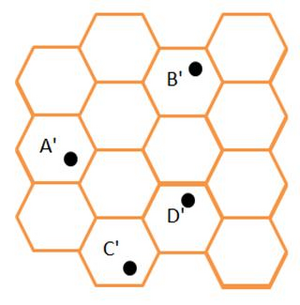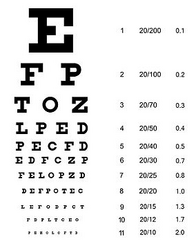The resolution of the human eye
Distinctive powers of the eye[edit | edit source]
Resolution limit of the eye[edit | edit source]
The distinguishing limit of the eye ( minimum separabile ) is the ability of the eye to distinguish two points that are as close as possible. The dot appears on the retina of the emmetropic (healthy) eye as a small scattering ring. Two points can be distinguished from each other only if there is at least one free cone not affected by light on the retina between their images - scattering rings .
Schematic structure of cones on the retina. Photosensitive cells and their functions|Images A', B' are perceived separately because there is a cone between them not affected by light . Photosensitive cells and their functions Cone C' and D' merge into one perception.
The diameter of the cone is about 0.005 mm and the distance of the retina from the image nodal point of the eye is about 17 mm. The angular distance of still distinguishable points is therefore:
ψo=0,005/17=0,0003 rad=1'
The resolution limit depends on contrast , brightness and the number of details observed. The limit ψo=1' is reached when observing black lines on a white background with suitable lighting.
Vernier resolution limit of the eye[edit | edit source]
The vernier resolution of the eye measures the quality of the degree of continuity (coincidence) when tracing two apparently connected straight lines. It is approximately 20 times higher than the minimum separable, i.e. 10" to 5".
Fig.1 – parallel lines will be perceived separately due to the mutual overlap of their ends.
Fig. 2 – the perception of parallel lines will represent merging into one line, because they are displayed on one row of cones.
Visual acuity[edit | edit source]
The quality of vision is determined by visual acuity, or vision. In addition to the minimum separabile, it also involves the ability to know - minimum cognibile and the ability to read - minimum legibile. It can be measured using optotypes - boards with figures (Snellen chart , pictorial optotype, Pflüger hooks, Landolt circles and others). Sharpness is expressed as a fraction, the numerator of which is the observation distance (when testing is usually 6 m or 5 m) and the denominator is the line number of distinguishable characters on the optotype. A value of V=1 (i.e. 6/6 or 5/5) is considered a normal visa.
Sharpness is influenced by physical ( defects of the optical apparatus ), physiological (adaptation of the eye to the intensity or power of light , distribution of sensory elements ) and psychological ( attention ) factors. When increasing the intensity of lighting up to 100 lux , the quality of visual acuity increases, up to 1000 lux it remains constant. At higher light intensity, it decreases due to glare. Visual acuity decreases from the center of the retina to its periphery, where the density of sensory elements is lower and one efferent fiber corresponds to more rods and cones .
Links[edit | edit source]
Related Articles[edit | edit source]
- The principle of vision
- Eye (Biophysics)
- Eye (Histology)
- Refractive defects
- Defects of the eye
- Biochemistry of the vision process
- Accommodation
References[edit | edit source]
- ANTON, M.. Refrakční vady a jejich vyšetřovací metody. 3. edition. Národní centrum ošetřovatelství a nelékařských zdravotnických oborů, 2004. ISBN 80-7013-402-X.
- BALÍK, J.. Technický sborník oční optiky. 2. edition. Nakladatelství technické literatury ve Středisku interních publikací, 1975.
- KŘÍŽ, P. Visual acuity: Bachelor thesis [online]. Brno, 2007. Available from: https://is.muni.cz/th/gkqtl/Bakalarka-Zrak.Ostrost.txt?so=nx




